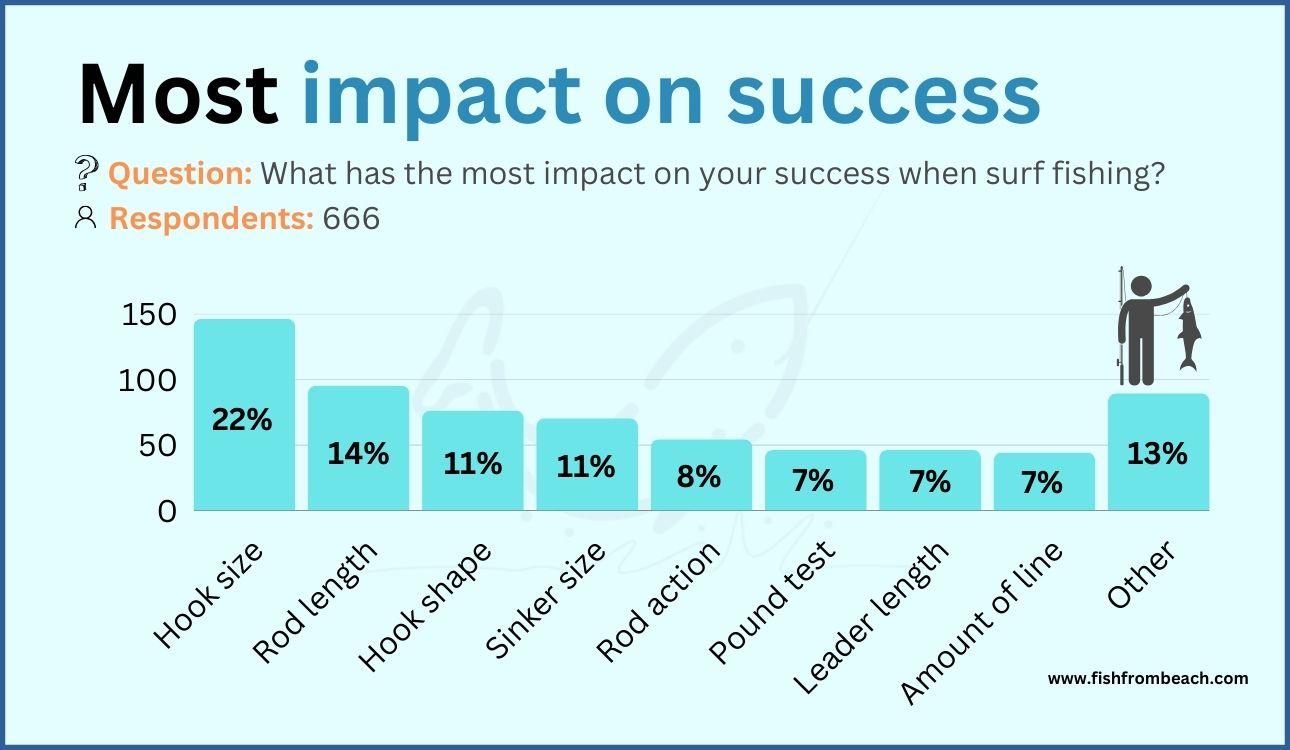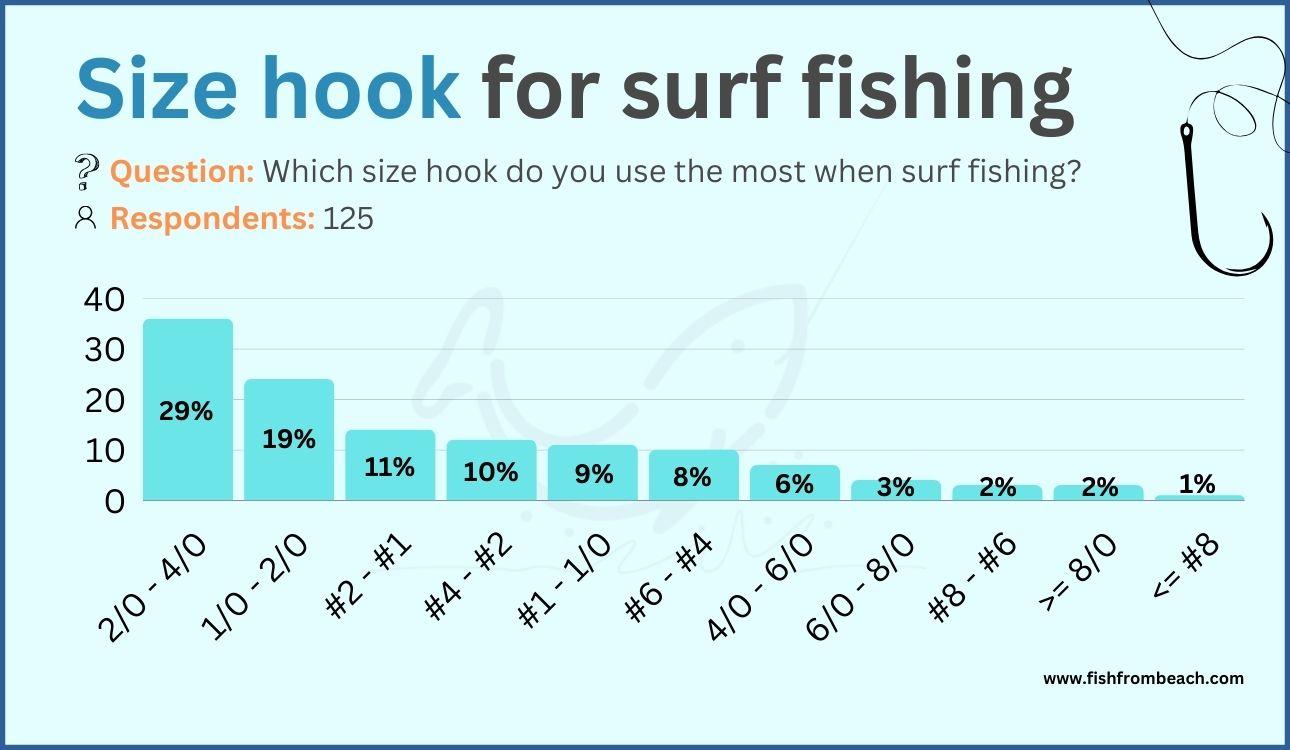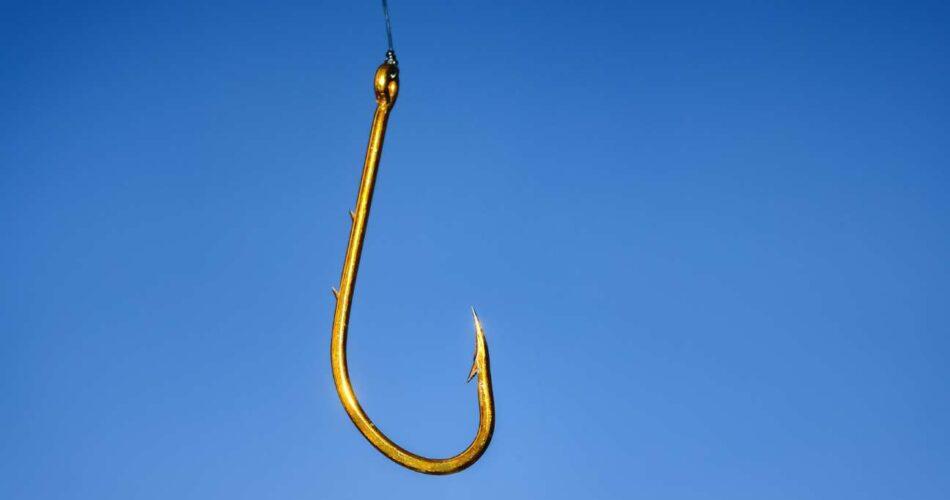When we surveyed 666 surf anglers about the factors they believe have the greatest influence on their success in surf fishing, it was surprising to find that the hook size and shape occupied the top and third place, respectively, with a combined 33% of the votes (220 respondents).
In other words, most respondents consider the hook size and shape to have more impact on their results than the rod action, pound test, leader length, and sinker size.

This highlights the importance of carefully selecting the size of your hooks, as making a poor choice can have a significant impact on your results.
This is why I decided to write this post.
In this article, we will discover the factors to consider when choosing a hook for surf fishing, and what are the best sizes and shapes that yield the best results off the beach.
What is the best size hook for surf fishing?
When it comes to choosing a hook size, it’s a common misconception that the size of the hook should match the size of the fish you want to catch.
However, it’s actually more important to match the size of the hook with the size of the bait.
Yes, it may seem logical to use a larger hook for a larger fish, but using a hook that is too big for the bait can make it difficult for the fish to strike.
On the flip side, a hook that is too small may not be able to hold the bait securely, leading to many unsuccessful casts.
That being said, it’s also important to match the size of the bait to the size of the fish you target.
The goal is to present something that can draw the attention of fish without intimidating them.
It’s also advisable to use a bait that fish can swallow in a single strike.
So the process to decide on a good-sized hook for surf fishing is to first choose an effective bait for the fish you want to catch, then pick the hook that will ensure a proper presentation for that bait.
A good bait presentation means 3 simple things:
- The bait holds securely on the hook and won’t crumble or fly off after the cast
- Fish cannot steal the bait easily without getting caught
- The bait looks appetizing and appealing to the fish
And as we said before, it’s also preferred that the bait can be swallowed whole in one strike.
Ok, now which size to choose?
Well, most fish we catch in the surf measure less than 20 inches. This means the mouths we face are small and therefore require tiny chunks of food.
Therefore, your bait when surf fishing should generally not exceed 3 inches.
Larger baits can bring a few bites too, but they risk looking intimidating for a wide range of species.
On the other hand, avoid baits smaller than 1 inch.
They may not be noticeable to game fish and could attract a lot of unwanted (small) species.
The most common species in the surf zone are pompano, weakfish, surfperch, seatrout, bream, porgy, flounder, Spanish mackerel…etc.
As said before, most of these species do not exceed 20 inches in length and therefore require small baits to catch them.
So in my view, if you are fishing just for fun and will be happy with any fish you catch, then you only need hooks within the #2 – 3/0 range to get the results you want.
This range is what you need to ensure a good presentation for most baits that work in the surf.
Now, if you are only interested in large fish and want to keep the small ones away, you can go for larger baits and thus larger hooks.
In our surf fishing survey, the preferred hook sizes for surf fishing varied.
The most common size range was 2/0 – 4/0 accounting for 28.80% of votes (36 respondents).
The range 1/0 – 2/0 followed closely behind with 19.20% of votes.
Small to medium-sized hooks encompassing sizes such as #6, #4, #2, #1, and 1/0 received a combined total of 37.60% of votes, indicating a significant preference for small hooks.
Additionally, a few respondents reported using hooks larger than 8/0 (2.40% or 3 votes) or smaller than #8 (0.80% or 1 vote).

What is the best hook shape for surf fishing?
The choice of a hook shape for surf fishing depends on various factors, including the type of bait you’re using, the size of fish you’re targeting, and the specific surf conditions
However, I believe that the most common hook shapes among surf anglers are:
- Circle hooks
- Bait holders
- J-hooks



In the following lines, we compare them in different areas and see which one yields the best fishing.
Catch and release efficiency
Circle Hooks: Circle hooks excel in catch and release scenarios due to their unique design. With the point curving back towards the shank, the chances of deep hooking or causing vascular wounds are slim. This intelligent design directs the hook to catch the fish on the lips, usually at the corner of the mouth, reducing the risk of mortality. A study comparing circle and J-hooks showcases the significant eco-friendly advantage of circle hooks. The mortality rate with circle hooks is notably lower at 10.4% compared to J-hooks at 19.0%. Also, the incidence of deep hooking is only 4% with circle hooks, whereas J-hooks show a higher rate at 21%.
J-Hooks and Bait Holders Hooks: While effective in hooking fish, J-Hooks and bait holder hooks have a higher mortality rate and a greater tendency for deep hooking. The exposed point design of such hooks poses a risk of hooking vital organs, such as the stomach and gills, which decreases the chances of the fish’s survival if released back into the surf.
Bait Retention
Circle Hooks: The unique design of circle hooks focused on reducing deep hooking, also contributes to effective bait retention. The curve back towards the shank helps keep the bait securely in place.
J-Hooks: J-hooks may have slightly lower bait retention compared to circle hooks. The exposed point design may increase the likelihood of bait displacement during aggressive bites or when dealing with strong currents.
Bait Holder Hooks: As their name suggests, bait holders are the go-to option when struggling to secure baits. Their small barbs along the shank help anchor the bait securely, providing stability in turbulent waters or when targeting fish known for aggressive strikes.
Bait presentation
Circle Hooks: Circle hooks are the go-to option when presenting live bait. Their rounded shape lets the bait move naturally in the water. Also, the wide gap in these hooks allows for a more lifelike presentation, making them a solid choice for surf anglers.
J-Hooks: J-Hooks are versatile and can handle different bait sizes and types. Whether you’re using whole or cut bait, it’s easy to adapt J-Hooks to a rewarding presentation that attracts fish.
Bait Holder Hooks: As said above, these hooks are specialized in holding bait securely. Therefore, they are a smart choice when presenting natural baits in challenging surf conditions. Worth noting that bait holders tend to work the best with worms, cut bait, and other soft baits.
The Need for a hookset
Circle Hooks: Circle hooks shine in their ability to hookset biting fish without requiring any manual intervention. Their smart design allows them to pivot after a bite, exposing the hook point to the jaw’s internal parts. When a fish takes the bait, applies pressure, and runs with it, the hook rotates inside the mouth, catching the lips and penetrating the corner. This eliminates the need for anglers to set the hook manually, offering a significant advantage, especially when deploying baits at longer distances.
J-Hooks & Bait Holder Hooks: In contrast, J-hooks and bait holder hooks demand a manual hookset, which requires constant vigilance from surf anglers, particularly when deploying baits at extended distances. In other words, anglers need to be attentive and ready to respond quickly when a fish takes the bait.
The snag rate
Circle Hooks: The design of circle hooks, with the point heading back to the shank, keeps their sharpest part hidden. This ingenious design ensures a minimal snag rate, making them ideal for fishing in heavy cover, rocky areas, and locations filled with rocks, weeds, and barnacles.
J-Hooks & Bait Holder Hooks: With their exposed point, J-hooks and bait holder hooks may have a higher tendency to snag in challenging conditions. Therefore, they are not the best choice when fishing seabeds with heavy cover or obstacles.
Against sharp-tooted fish
Circle Hooks: Circle hooks offer protection when targeting sharp-toothed fish such as bluefish, Spanish mackerel, and sharks. By ensuring that the hook stays at the corner of the fish’s mouth, the risk of the line being cut is minimized.
J-Hooks & Bait Holder Hooks: J-hooks and bait holders, depending on size and design, may expose the line to more risk from sharp-toothed fish. Thicker leaders might be necessary for added protection. Worth noting here, that the longer the shank of your hook, the harder it is for fish to bite through your line. In other words, short-shanked hooks are the most prone to sharp teeth because they allow fish to reach your line easily.
So which hook shape to choose for surf fishing?
Well, it’s obvious that the answer depends on various factors such as the type of bait, target species, and fishing conditions. However, I would always recommend circle hooks for their effectiveness, versatility, and ease of use.
As discussed above, circle hooks ensure an effective bait presentation that attracts fish while still protecting your gear from snags, abrasion, and the sharp teeth of fish.
In addition, circle hooks offer the additional advantage of automatic hooksets. Meaning, you don’t need to worry about reaching late to your shaking rods. The hook will do the job for you and secure the catch. This is especially important for novice anglers who are still learning how to set hooks.
Also, for anglers prioritizing conservation and catch and release, circle hooks are clearly the way to go.
J-Hooks and bait holders work great too, especially if you put the effort to rationalize your choice based on your conditions and objectives. However, remember that you still need to set the hook when using them. Their shape cannot pierce the fish’s jaws without action from your end.
Also, these hooks are easy to swallow by the fish and therefore run a high risk of gut hooking them to death.
Note (*): If you make a purchase through links from this website, we may get a small share of the sale from Amazon or other similar affiliate programs.
Surf Fishing Survey
Help us provide you with better content by answering simple questions about your surf fishing experience and knowledge.
We will put the collected responses together and turn them into valuable information that will help you catch more fish from shore 😉
Note: No personal information will be collected with your answer.

